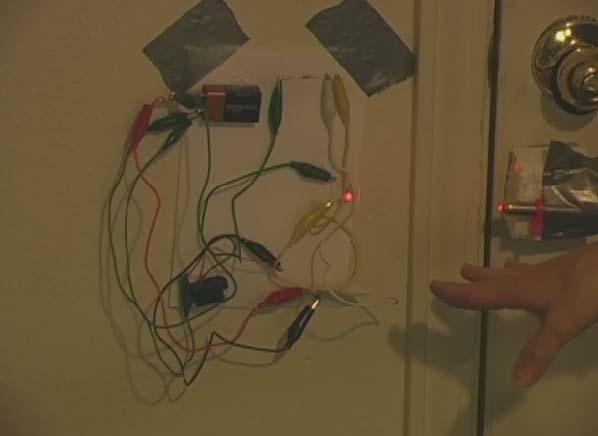If you've already made the Laser Burglar Alarm (which is highly recommend doing FIRST), then you're probably wondering how to make the circuit act in the opposite way... meaning how do you make it so that the buzzer sounds when the light is turned off?
This circuit requires more patience and parts, but it's totally worth it. It uses the same parts as the previous experiment (plus a few more) with a couple of extra twists and turns in the circuit to let the buzzer know when it's time to turn off. Use this in doorways or as an invisible trip wire trigger across hallways.
Materials:
- Red laser pointer
- 9V battery or two AA's in a AA battery pack
- 7 alligator clip leads
- CdS Cell
- 9V Battery OR 2 AA's in a battery holder
- NPN Transistor 2N3904 or 2N222A
- 4.7k-ohm resistor
- Buzzer (3-6V)


Yes, a 3 volt buzzer will work.
Can you use a 3-Volt buzzer?
Give it a try. Flashlights put out a wider beam, so it won’t be as precise. But it should still work.
Do flashlights work too? We don’t have lasers.
No problem – if you’re using 9V, just clip right onto the battery. If you’re using two AAs, use the rubber band idea and hoop the batteries up plus to minus to get 3V.
Yeah! Thanks! This experiment looks really cool, and I have everything to do it, except I forgot the battery case:)
Sure – we used to wrap a rubber band lengthwise around the battery a couple of times and then insert paperclips into each end to make terminals to connect onto. Does that give you any ideas?
Hi,
Is there any way that you could make a battery case? What I understand one to be is a box, with two wires on either ends. When you put the batteries in they fit snugly and touch the wires thereby conducting electricity. One side would be positive and one side would be negative. ???. Just wondering . . .
🙂 Jasmin
Welcome to our science family! Here’s a particularly annoying-sounding buzzer from Radio Shack, or you could use a siren.
Hi Aurora,
I am looking for a buzzer from the materials list. It says it needs to be a 3-6 V buzzer. On the RadioShack site, they sell a buzzer that says 75dB Piezo Electric Buzzer, would this be the same thing? If not, how could I get the right one? By the way, I just became an affiliate! And I can’t wait to get my first “referral”. Thank you. X.